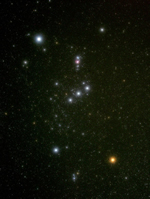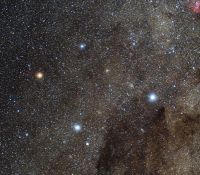Activity 7 |
Globe at Night |
| |
Globe at Night is an international citizen-science campaign to raise public awareness of the impact of light pollution by encouraging everyone everywhere to measure local levels of night sky brightness and contribute observations online to a world map. For more information go to the web site http://www.globeatnight.org/ |

Image from:
www.astronet.ru/db/xware/msg/
apod/2008-10-15
|
Please take part in 'Globe@Night between 19 - 28 January or 18 - 27 February 2017 using Orion or later in the year: 18 - 27 April or 17 - 26 May using Crux.
This can actually be quite a fun activity for the whole family.
Who or what is Orion?
Orion is a constellation it the sky and at this time of year he will be visible in the northwestern sky here in the southern hemisphere. You are looking for three bright stars close together in an almost-straight line. These three stars represent Orion's belt. The two bright stars to the north are his shoulders and the two to the south are his feet.
If this does not help, please ask your parents or teacher to help you. You can also download stellarium and install it on your computer.
"Stellarium is a free open source planetarium for your computer. It shows a realistic sky in 3D, just like what you see with the naked eye, binoculars or a telescope." Go to http://www.stellarium.org/
And if you still need help - phone somebody in your group.
What to do?
- Find Orion by going outside an hour after sunset (approximately between 8-10 pm local time) Determine the darkest area by moving to where the most stars are visible in the sky toward Orion.
- If you have outside lights, be sure they are all off.
- Wait outside for at least 10 minutes (20 minutes would be better) for your eyes to adapt to the darkness. This is called becoming “dark-adapted.”
- Locate Orion in the sky. Match your nighttime sky to one of our magnitude charts on the Globe at Night worksheet. If you are not able to determine your GPS co-ordinates, don't worry, we'll do it here on 25 February and then upload your observation.
- Complete the worksheet and bring it along on 25 February.
|

Image from:
en.es-static.us/upl/2009/06/
southern_cross_350.jpg
|
Who or what is Crux?
The constellation Crux is easily visible from the southern hemisphere at practically any time of year.
Crux is also referred to as “the Southern Cross” and is the smallest constellation in the sky. The brilliant cross is formed by bright stars making it one of the most familiar sights in the southern hemisphere.
The constellation has been used as insignia on the flags and stamps of many southern hemisphere nations, including Australia, New Zealand, Brazil, Papua New Guinea and regions of Chile and Argentina. (From Globe at Night) |
| Stellarium |
If you want to learn more about the night sky, download the Stellarium software. Stellarium is a free open source planetarium for your computer. It shows a realistic sky in 3D, just like what you see with the naked eye. Go to www.stellarium.org/ and follow the instructions to get a planetarium on your computer. |
References & Resources
|
| Admin Pages |
Schedule 2017 |
Group R - Reflections |
|
Helga Nordhoff
Last updated: 27 January 2017
|